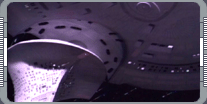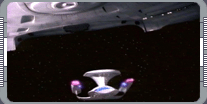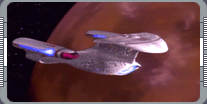
Saucer Separations
The USS Enterprise could separate the saucer section main drive, offering more flexibility in
emergencies.
 When Starfleet vessels first started exploring the unknown regions of space the crew had no choice but
to leave their families behind, sometimes in the knowledge that it would be years before they would see
their loved ones again. As starship design progressed, however, it became possible to install
extended living quarters and children to live on board with them.
When Starfleet vessels first started exploring the unknown regions of space the crew had no choice but
to leave their families behind, sometimes in the knowledge that it would be years before they would see
their loved ones again. As starship design progressed, however, it became possible to install
extended living quarters and children to live on board with them.
Having so many civilians aboard the ship cause its own problems, such as placing them in danger. For this
reason many family ships, such as the Galaxy-class, incorporated a
very important safety design: a saucer section that could be separated from the rest of the ship. This allowed
the Starfleet crew to go into dangerous situations while their families could be evacuated to the saucer section
and taken out of the line of fire. This feature also proved to be a life-saver in the case of a warp core
breach. All nonessential personnel could be evacuated to the saucer module, away from the drive section that
housed the warp core. As long as the saucer section had time to reach a fare distance, casualties could be kept
to a minimum.
There are 18 docking clamps on Galaxy-class starships locking the engineering and primary hulls together.
 Originally separations were intended for sub-light speeds only, until 2364 when the
USS Enterprise NCC-1701-D performed the first warp speed
separation. The saucer section is only powered by impulse engines, with the warp nacelles located on the
stardrive section, released at warp however the saucer will travel on momentum for a short while. Aside for
it's practical purpose of getting civilians out of danger, the saucer can also be used for a tactical advantage.
Onboard all Starfleet vessels the main bridge is located on the saucer and a battle bridge is located in the
stardrive section. Using two ships instead of one, it's be easier to distract and attack an enemy ship from
different locations.
Originally separations were intended for sub-light speeds only, until 2364 when the
USS Enterprise NCC-1701-D performed the first warp speed
separation. The saucer section is only powered by impulse engines, with the warp nacelles located on the
stardrive section, released at warp however the saucer will travel on momentum for a short while. Aside for
it's practical purpose of getting civilians out of danger, the saucer can also be used for a tactical advantage.
Onboard all Starfleet vessels the main bridge is located on the saucer and a battle bridge is located in the
stardrive section. Using two ships instead of one, it's be easier to distract and attack an enemy ship from
different locations.
 Starfleet personnel have to be trained to land a saucer module in the even of an emergency. This
maneuver has rarely been undertaken, as it is performed only in a worst-case scenario when all other
options have been exhausted. When the Enterprise-D was attacked by a Klingon D-12 type Bird-of-Prey which had
the shield frequency it caused a warp core breach. The saucer section used to evacuate the entire crew, which
crash landed on Veridian III from the huge shock wave caused by the explosion of the Enterprise's engineering
hull. The saucer was still able to be piloted with enough control to land it intact. However the saucer
section does not have enough power to take-off on it's own and is usually unsavageable.
Starfleet personnel have to be trained to land a saucer module in the even of an emergency. This
maneuver has rarely been undertaken, as it is performed only in a worst-case scenario when all other
options have been exhausted. When the Enterprise-D was attacked by a Klingon D-12 type Bird-of-Prey which had
the shield frequency it caused a warp core breach. The saucer section used to evacuate the entire crew, which
crash landed on Veridian III from the huge shock wave caused by the explosion of the Enterprise's engineering
hull. The saucer was still able to be piloted with enough control to land it intact. However the saucer
section does not have enough power to take-off on it's own and is usually unsavageable.
|
|
"U.S.S. ENTERPRISE NCC-1701-D" - SEPTEMBER 1999 ISSUE 5 STAR TREK: THE MAGAZINE. COPYRIGHT OF PARAMOUNT PICTURES.
|